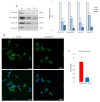Iron-Chelation Treatment by Novel Thiosemicarbazone Targets Major Signaling Pathways in Neuroblastoma
- PMID: 35008802
- PMCID: PMC8745636
- DOI: 10.3390/ijms23010376
Iron-Chelation Treatment by Novel Thiosemicarbazone Targets Major Signaling Pathways in Neuroblastoma
Abstract
Despite constant advances in the field of pediatric oncology, the survival rate of high-risk neuroblastoma patients remains poor. The molecular and genetic features of neuroblastoma, such as MYCN amplification and stemness status, have established themselves not only as potent prognostic and predictive factors but also as intriguing targets for personalized therapy. Novel thiosemicarbazones target both total level and activity of a number of proteins involved in some of the most important signaling pathways in neuroblastoma. In this study, we found that di-2-pyridylketone 4-cyclohexyl-4-methyl-3-thiosemicarbazone (DpC) potently decreases N-MYC in MYCN-amplified and c-MYC in MYCN-nonamplified neuroblastoma cell lines. Furthermore, DpC succeeded in downregulating total EGFR and phosphorylation of its most prominent tyrosine residues through the involvement of NDRG1, a positive prognostic marker in neuroblastoma, which was markedly upregulated after thiosemicarbazone treatment. These findings could provide useful knowledge for the treatment of MYC-driven neuroblastomas that are unresponsive to conventional therapies.
Keywords: DpC; EGFR; MYC; NDRG1; lipid droplet; neuroblastoma; thiosemicarbazone.
Conflict of interest statement
The authors declare no conflict of interest.
Figures









Similar articles
-
The Metastasis Suppressor, N-MYC Downstream-regulated Gene-1 (NDRG1), Down-regulates the ErbB Family of Receptors to Inhibit Downstream Oncogenic Signaling Pathways.J Biol Chem. 2016 Jan 15;291(3):1029-52. doi: 10.1074/jbc.M115.689653. Epub 2015 Nov 3. J Biol Chem. 2016. PMID: 26534963 Free PMC article.
-
Innovative therapies for neuroblastoma: The surprisingly potent role of iron chelation in up-regulating metastasis and tumor suppressors and down-regulating the key oncogene, N-myc.Pharmacol Res. 2021 Nov;173:105889. doi: 10.1016/j.phrs.2021.105889. Epub 2021 Sep 16. Pharmacol Res. 2021. PMID: 34536548 Review.
-
Novel Thiosemicarbazones Inhibit Lysine-Rich Carcinoembryonic Antigen-Related Cell Adhesion Molecule 1 (CEACAM1) Coisolated (LYRIC) and the LYRIC-Induced Epithelial-Mesenchymal Transition via Upregulation of N-Myc Downstream-Regulated Gene 1 (NDRG1).Mol Pharmacol. 2017 May;91(5):499-517. doi: 10.1124/mol.116.107870. Epub 2017 Mar 8. Mol Pharmacol. 2017. PMID: 28275050
-
Targeting the Metastasis Suppressor, N-Myc Downstream Regulated Gene-1, with Novel Di-2-Pyridylketone Thiosemicarbazones: Suppression of Tumor Cell Migration and Cell-Collagen Adhesion by Inhibiting Focal Adhesion Kinase/Paxillin Signaling.Mol Pharmacol. 2016 May;89(5):521-40. doi: 10.1124/mol.115.103044. Epub 2016 Feb 19. Mol Pharmacol. 2016. PMID: 26895766 Free PMC article.
-
The Role of Extracellular Proteases in Tumor Progression and the Development of Innovative Metal Ion Chelators that Inhibit their Activity.Int J Mol Sci. 2020 Sep 16;21(18):6805. doi: 10.3390/ijms21186805. Int J Mol Sci. 2020. PMID: 32948029 Free PMC article. Review.
Cited by
-
Chelators as Antineuroblastomas Agents.Physiol Res. 2023 Oct 27;72(S3):S277-S286. doi: 10.33549/physiolres.935184. Physiol Res. 2023. PMID: 37888971 Free PMC article.
-
Thiosemicarbazones and selected tyrosine kinase inhibitors synergize in pediatric solid tumors: NDRG1 upregulation and impaired prosurvival signaling in neuroblastoma cells.Front Pharmacol. 2022 Sep 7;13:976955. doi: 10.3389/fphar.2022.976955. eCollection 2022. Front Pharmacol. 2022. PMID: 36160437 Free PMC article.
-
PKCδ promotes the invasion and migration of colorectal cancer through c-myc/NDRG1 pathway.Front Oncol. 2023 Feb 2;13:1026561. doi: 10.3389/fonc.2023.1026561. eCollection 2023. Front Oncol. 2023. PMID: 36816970 Free PMC article.
-
Iron Chelator VLX600 Inhibits Mitochondrial Respiration and Promotes Sensitization of Neuroblastoma Cells in Nutrition-Restricted Conditions.Cancers (Basel). 2022 Jun 30;14(13):3225. doi: 10.3390/cancers14133225. Cancers (Basel). 2022. PMID: 35805002 Free PMC article.
-
NDRG1 and its family members: More than just metastasis suppressor proteins and targets of thiosemicarbazones.J Biol Chem. 2025 Jul;301(7):110230. doi: 10.1016/j.jbc.2025.110230. Epub 2025 May 14. J Biol Chem. 2025. PMID: 40378957 Free PMC article. Review.
References
-
- Nuchtern J.G., London W.B., Barnewolt C.E., Naranjo A., McGrady P.W., Geiger J.D., Diller L., Schmidt M., Lou Maris J.M., Cohn S.L. et al. A prospective study of expectant observation as primary therapy for neuroblastoma in young infants: A children’s oncology group study. Ann. Surg. 2012;256:573. doi: 10.1097/SLA.0b013e31826cbbbd. - DOI - PMC - PubMed
MeSH terms
Substances
Grants and funding
LinkOut - more resources
Full Text Sources
Medical
Research Materials
Miscellaneous

